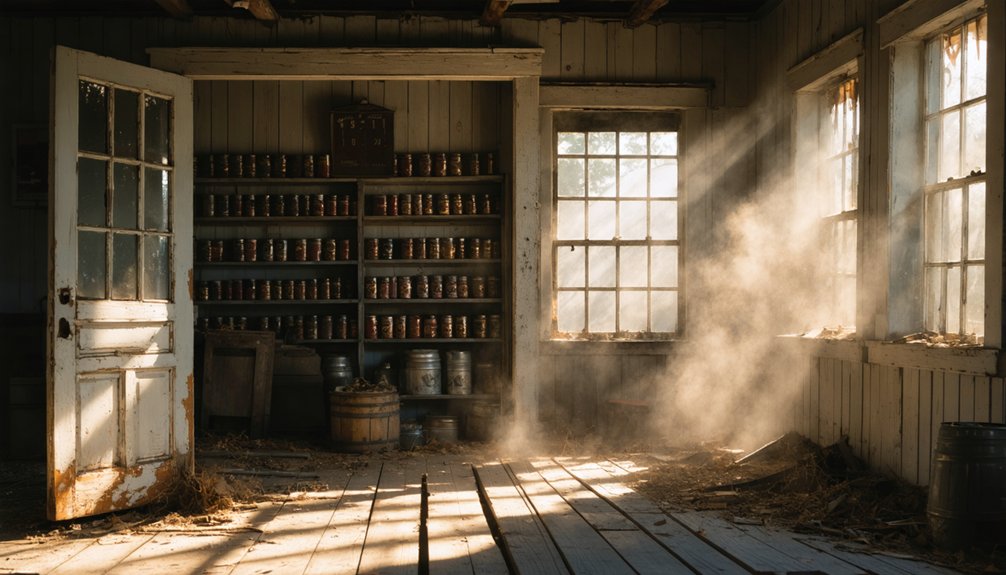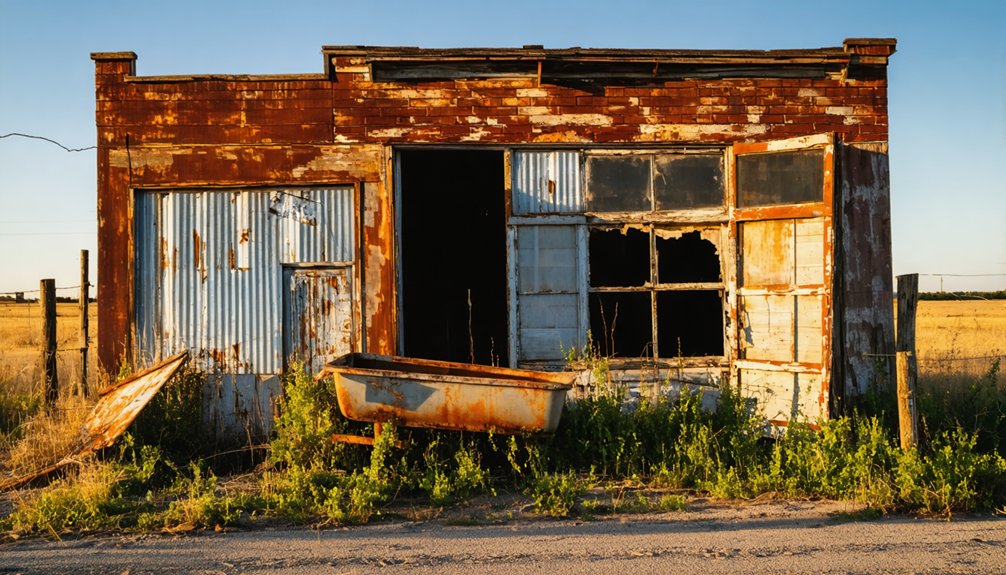You’ll find La Plata’s remains in Texas’s Deaf Smith County, where this once-promising frontier town emerged in 1883 as the county’s first seat. Though it thrived with a courthouse, hotel, and newspaper, the settlement couldn’t survive nature’s fury. A devastating drought (1891-1894) and brutal blizzard (1897) drove residents away, while the Pecos and Northern Texas Railway‘s decision to bypass the town sealed its fate by 1900. The site’s rich history holds more surprising twists and turns.
Key Takeaways
- La Plata was a ranching community established in the 1880s in Presidio County, Texas, which later became a ghost town.
- The town served as Deaf Smith County’s first administrative center before losing its county seat status in 1898.
- Natural disasters, including a devastating drought (1891-1894) and brutal blizzard (1897), drove away half the population.
- The Pecos and Northern Texas Railway’s decision to bypass La Plata in 1899 contributed significantly to the town’s decline.
- Today, only the cemetery remains on private farmland, with artifacts preserved at the Deaf Smith County Museum in Hereford.
The Birth of a Frontier Settlement
As the American frontier pushed westward in the 1880s, the settlement of La Plata emerged as a promising ranching community in east central Presidio County, Texas.
You’ll find its roots along Alamito Creek and Farm Road 169, where sixteen-year-old Robert Reed Ellison drove nearly 3,000 head of cattle in March 1883, establishing the area’s ranching foundation.
La Plata’s strategic location near the Atchison, Topeka and Santa Fe Railway sparked settlement growth, transforming the raw frontier into a bustling cattle hub.
The community’s early development centered on ambitious goals, with ranching interests driving its expansion.
While initially named La Plata, the settlement later became known simply as Plata, marking its place in Texas history as one of many frontier towns vying for regional prominence during the late 19th century.
The town established several key structures including a courthouse and hotel, positioning itself as a significant regional center.
The Kansas City, Mexico and Orient Railway designated Plata as a railway station in 1930, further solidifying its importance to the region.
Power Struggles and Political Rivalry
You’ll find the story of La Plata’s power struggle centered on the fierce county seat battle of 1890, when this XIT Ranch-founded town competed against neighboring Ayr for political supremacy.
The rivalry sparked a controversial October election, where La Plata (then called Grenada) emerged victorious by a narrow margin and quickly established key institutions like a courthouse, jail, and newspaper to cement its authority. Texas Rangers were dispatched to maintain peace during the heated election process.
Despite winning the coveted county seat status, La Plata’s political control remained tenuous as environmental hardships and railway decisions gradually eroded its position of influence. A new small frame courthouse was hastily constructed using lumber transported from Amarillo to establish governmental operations.
County Seat Battle
When Deaf Smith County officially organized in 1890, a fierce political battle erupted between the towns of Grenada (later La Plata) and Ayr for the coveted position of county seat.
The election on October 3rd became a flashpoint for concerns about election integrity when XIT Ranch cowboys allegedly cast multiple votes to support Grenada’s bid. The situation grew so tense that Texas Rangers were called in to maintain order.
Despite claims of corruption and political influence from the powerful XIT Ranch, Grenada emerged victorious as the county’s first seat of government. The newly elected officials promptly authorized construction of a temporary courthouse facility funded by taxes on non-resident property.
In 1898, the county seat moved to the town of Hereford, marking another significant change in local governance. This outcome proved devastating for rival Ayr, which saw its fortunes decline sharply in the aftermath. By 1895, Ayr had lost its post office and was fundamentally abandoned, marking a decisive end to the contentious county seat battle.
XIT Ranch Political Control
The sprawling XIT Ranch emerged as the dominant political force across the Texas Panhandle in the late 19th century, wielding enormous influence through its three-million-acre footprint and economic might. The massive operation, which ran 150,000 cattle at its peak, gave the ranch unprecedented economic leverage in regional politics. The ranch’s extensive infrastructure included telephone lines connecting critical operational points, enabling swift communication and coordination of political activities.
You’ll find the ranch’s political alliances stretched across ten counties, where ranch influence shaped everything from law enforcement to local elections.
Key aspects of XIT’s political control included:
- Installing sympathetic officials through patronage and campaign support
- Using economic leverage to influence legislative and judicial decisions
- Maintaining control over local media to shape public opinion
- Resisting settler-driven reforms that threatened ranch operations
The power struggles between XIT management and incoming settlers created deep divisions, often erupting into heated electoral battles and disputed court cases that defined the region’s political landscape.
Life in Early La Plata
You’d have found La Plata’s early residents gathering at the town’s saloon, hotel, and general store, where ranchers and townspeople conducted business and socialized after long days of work.
The community’s printing office produced the *La Plata Star* newspaper, while the blacksmith shop rang with the sounds of essential repairs for local ranching operations.
At the heart of daily life, the courthouse and church served as focal points for both official proceedings and social events, creating a rhythm of activity that defined this frontier settlement of roughly 28 households. A devastating blizzard in 1897 struck the town, leading many residents to abandon their homes and businesses.
Daily Pioneer Routines
Life in early La Plata revolved around a demanding sunrise-to-sunset schedule, with farmers and ranchers rising before dawn to maximize precious daylight hours.
You’d start your pioneer chores by tending to livestock care, ensuring cattle were fed and watered before the Texas heat intensified. The humid subtropical climate made daily work particularly challenging during summer months. The harsh frontier conditions meant you couldn’t waste a moment of daylight.
Your daily survival depended on completing these essential tasks:
- Fetching water from wells or creeks for household and farming needs
- Maintaining crucial farming equipment at the local blacksmith
- Preparing meals using locally sourced and preserved foods
- Tending to crops while battling unpredictable weather patterns
During droughts or blizzards, you’d adapt your routine, often working with neighbors to share resources and support the tight-knit ranching community‘s survival.
Community Gatherings and Events
Despite harsh frontier conditions, social connections flourished in early La Plata through carefully orchestrated community gatherings.
You’d find religious gatherings at the Presbyterian church serving as the cornerstone of community life, hosting Sunday services and holiday celebrations that strengthened neighborly bonds.
The local schoolhouse doubled as a venue for cultural events, where you could join other settlers for educational programs and public readings of the La Plata Star newspaper.
After a hard day’s work, you might’ve unwound at the saloon or participated in seasonal festivals that lifted spirits during tough times.
Political engagement peaked during the heated county seat election of 1890, while civic celebrations marked the town’s progress with the establishment of new public buildings.
Frontier Business Operations
While many frontier towns struggled to establish diverse commerce, La Plata quickly developed a robust business district anchored by crucial services. The town’s business diversity reflected the needs of a growing ranching community, demonstrating remarkable economic resilience for a frontier settlement.
You’d find these crucial commercial establishments serving the community:
- A well-stocked general store and implement house supplying ranchers with crucial goods and agricultural equipment.
- Service-oriented businesses like the blacksmith shop and livery stable supporting transportation and ranch operations.
- A hotel and saloon providing lodging and social gathering spaces for travelers and residents.
- Professional services including a post office, pharmacy, and printing office producing the “La Plata Star” newspaper.
These businesses formed an interconnected network that supported both local residents and the region’s flourishing cattle industry.
The Rise and Fall of a County Seat

During its brief but notable reign as county seat, La Plata emerged from humble beginnings as Grenada in 1890 to become Deaf Smith County’s first administrative center.
You’ll find its early promise reflected in the rapid development of essential institutions – a courthouse, jail, school, and various businesses served the growing community’s needs.
But settlement challenges soon took their toll. A devastating drought from 1891-1894 crippled the agricultural economy, while a brutal 21-day blizzard in 1897 drove away half the population.
These environmental hardships proved too much for the fledgling town. When the Pecos and Northern Texas Railway bypassed La Plata in favor of Hereford in 1899, the town’s fate was sealed.
You can trace La Plata’s final decline to 1898, when it lost its county seat status and saw its buildings literally carted away to Hereford.
Legacy of a Lost Town
Although La Plata’s physical structures have vanished from the Texas plains, the town’s lasting impact on Deaf Smith County’s development remains significant.
You’ll find its legacy preserved through both tangible artifacts and cultural influences that shaped the region’s identity.
Four key elements define La Plata’s enduring legacy:
- The *La Plata Star* newspaper established the county’s first information network.
- The preserved jail at the Deaf Smith County Museum serves as a symbol of frontier justice.
- The town’s role in Texas Historical Markers helps document the area’s settlement patterns.
- Its appearance in Stephen King’s literature elevated it beyond local historical significance.
Despite economic challenges that led to its demise, including devastating droughts and the critical railway bypass, La Plata’s story exemplifies the resilient spirit of Texas frontier settlements.
Visiting the Ghost Town Today

When modern visitors seek out La Plata’s remains, they’ll find a stark contrast to the once-bustling frontier town.
Today, the site lies on private farmland, requiring careful ghost town navigation and landowner permission for access. You’ll need to plan ahead, bringing essential supplies and reliable maps, as cell service is limited in this remote area.
The cemetery remains the only physical trace of La Plata, though it’s situated on private property with restricted access.
For tangible connections to the town’s history, you’ll want to visit the Deaf Smith County Museum in nearby Hereford, where you can view the preserved jail and other artifacts.
Remember to check weather conditions before traveling, as the region’s extreme climate can impact your visit considerably.
Frequently Asked Questions
What Happened to the Original Courthouse Building From La Plata?
Ever wonder about vanished landmarks? You’ll find the courthouse was disassembled in 1899 and moved by wagon to Blue Water (now Hereford), marking the end of its architectural significance in La Plata’s history.
Were There Any Notable Gunfights or Lawless Incidents in La Plata?
While you’ll find regional gunfights and lawless disputes throughout Texas frontier history, there aren’t any specifically documented shootouts within La Plata itself, though nearby towns experienced notable violent confrontations.
How Did Local Native American Tribes Interact With La Plata Settlers?
You’ll find that trade relations between La Plata settlers and local tribes were complex, marked by both cultural exchange and periodic conflict, especially with Comanche and Lipan Apache groups during the settlement period.
What Was the Average Property Value in La Plata During Its Peak?
You won’t find specific property market values from La Plata’s peak, as economic factors weren’t well documented. Historical records don’t preserve exact prices from this isolated ranching community.
Did Any Famous Historical Figures Ever Visit or Stay in La Plata?
Like searching for footprints in a sandstorm, you won’t find evidence of any famous visitors or historical figures staying in the town. Historical records don’t document any notable personalities passing through.
References
- https://sites.rootsweb.com/~txdeafsm/history/ghost-towns.htm
- https://mix941kmxj.com/see-how-two-texas-ghost-towns-battled-for-the-county-and-lost/
- https://www.hmdb.org/m.asp?m=155119
- https://en.wikipedia.org/wiki/List_of_ghost_towns_in_Texas
- https://www.ghosttowns.com/states/tx/laplata.html
- https://www.allacrosstexas.com/texas-ghost-town.php?city=Plata
- https://www.tshaonline.org/handbook/entries/la-plata-tx
- https://www.texasescapes.com/TexasGhostTowns/PlataTexas/PlataTexas.htm
- https://www.tshaonline.org/handbook/entries/plata-tx
- https://newstalk940.com/see-how-two-texas-ghost-towns-battled-for-the-county-and-lost/



